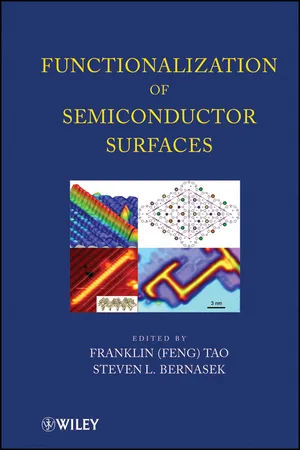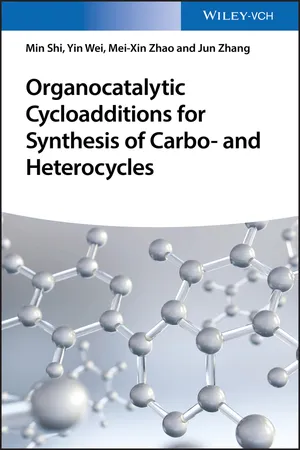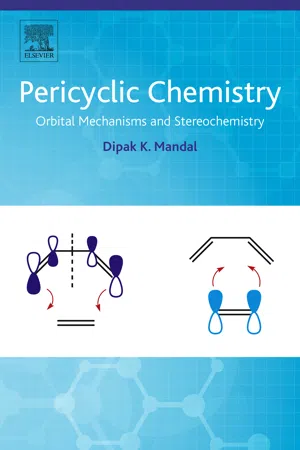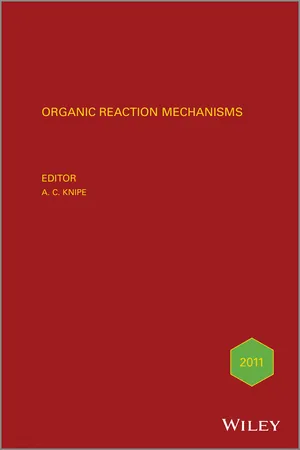Chemistry
Cycloaddition
Cycloaddition is a chemical reaction where two or more unsaturated molecules combine to form a cyclic product. It is a powerful tool for constructing complex ring structures in organic synthesis. The reaction can proceed through either a concerted or stepwise mechanism, and it is widely used in the preparation of pharmaceuticals, natural products, and materials.
Written by Perlego with AI-assistance
Related key terms
Related key terms
1 of 4
Related key terms
1 of 3
8 Key excerpts on "Cycloaddition"
- eBook - ePub
Active Pharmaceutical Ingredients in Synthesis
Catalytic Processes in Research and Development
- Anthony J. Burke, Carolina Silva Marques, Nicholas J. Turner, Gesine J. Hermann(Authors)
- 2018(Publication Date)
- Wiley(Publisher)
8 Catalytic Cycloaddition Reactions: Coming Full Circle To Mankind And the hope that war against folly may someday be won after all Isaac Asimov (1972), The Gods Themselves 8.1 Introduction Cycloaddition reactions have been used for the synthesis of active pharmaceutical ingredient s (API s). A Cycloaddition reaction is a pericyclic reaction which proceeds in a concerted manner via a cyclic transition state, and is one of the most powerful and elegant methods available for the construction of carbon─carbon bonds (including C–N and C–O as well). Cycloaddition reactions are a particularly useful reaction type as they allow the construction of ring systems in a precise stereocontrolled manner. Some of the most important Cycloaddition reactions are the Diels–Alder (DA) reaction (including the Hetero‐Diels–Alder (hDA) reaction) and the 1,3‐dipolar Cycloaddition including the Huigsen [3+2] Cycloaddition for the construction of 1,2,3‐triazoles. Catalytic Cycloaddition reactions are known, and they run smoother than their noncatalytic versions. These reactions are discussed in this chapter. 8.2 The “Classical” Catalytic Diels–Alder Reaction – Closing the Circle This reaction has a fabulous history and a Nobel Prize pedigree to boot. It was invented in 1928 by Otto Diels and Kurt Alder when they reacted – generally with unusual ease – a conjugated diene and a dienophile to give a cyclic product [1] - eBook - ePub
- Franklin Tao, Steven Bernasek(Authors)
- 2012(Publication Date)
- Wiley(Publisher)
Chapter 4 Pericyclic Reactions of Organic Molecules at Semiconductor Surfaces 1 Keith T. Wong and Stacey F. Bent 4.1 Introduction Pericyclic reactions comprise an important class of the chemistry of unsaturated organic molecules. Woodward and Hoffmann first proposed the concept of pericyclic reactions in 1965 [1]. These are reactions that are thought to occur via a concerted process involving a cyclic transition state, without the formation of intermediates. As a result of their concerted nature, pericyclic reactions are known to provide high stereoselectivity [2]. This chapter focuses on a particular type of pericyclic reaction, Cycloaddition reactions, in which π electrons from two or more unsaturated reactant molecules form new σ bonds between reactants to create a cyclic product. Due to the aforementioned stereoselectivity and their ability to form new carbon–carbon bonds and new carbon rings, Cycloadditions play a central role in organic synthesis [3, 4]. The two types of Cycloaddition reactions considered in this chapter are the [2+2] Cycloaddition and [4+2] Cycloaddition, where the reaction is named for the number of π electrons of each reactant molecule. [4+2] Cycloaddition is also known as the Diels–Alder reaction. The Woodward–Hoffmann selection rules describe the reactivity of such Cycloadditions. Symmetry analysis of the parity of the highest occupied molecular orbital (HOMO) and lowest unoccupied molecular orbital (LUMO), as depicted in Fig. 4.1, indicates that the [2+2] reaction is symmetry-forbidden due to a mismatch in parity whereas the Diels–Alder reaction is symmetry-allowed [5]. In fact, [2+2] Cycloadditions in organic chemistry typically require photochemical activation to excite one of the reactants to a state in which the parity of the HOMO and LUMO orbitals that form the new bonds is matched, and the reaction is symmetry-allowed - eBook - ePub
- Roderick Bates(Author)
- 2012(Publication Date)
- Wiley(Publisher)
11 Cycloaddition and Cycloisomerization ReactionsCycloaddition reactions are of enormous importance in organic synthesis, but they are necessarily limited by the Woodward–Hoffman rules. The majority of Cycloaddition reactions used in organic synthesis form six-membered ring carbocycles through the Diels–Alder reaction. Some four-membered rings can be formed, and a range of five-membered ring heterocycles can be formed by 1,3-dipolar Cycloadditions. The use of transition metals can not only facilitate the formation of these “convenient” ring sizes, but also permit the formation of other ring sizes.1 In addition, conventional Cycloadditions almost always involve the adding together of two components, such as a diene and a dienophile, while transition metals can allow three separate components to be brought together. The participation of the transition metal means that all of these reactions become formal Cycloadditions, and have multi-step mechanisms.11.1 Formal Six-Electron, Six-Atom Cycloadditions 11.1.1 The [4 + 2] CycloadditionThe Diels–Alder reaction is a cornerstone of organic synthesis, but it has its limitations. Principal among these is that diene/alkene pairs without suitable electronic activation react very slowly, if at all. Usually, an electron-poor alkene is employed. Enormous rate accelerations can be achieved with Lewis-acid catalysis. This form of catalysis requires that the substrate possesses a group conjugated to the alkene that is capable of coordination to the Lewis acid. An alternative means of catalysis is to use a transition metal, which works by coordinating directly to the π-systems, bringing them together and forming the bonds one by one.An effective catalyst for this reaction with diene–ynes and diene-allenes2 is Ni(COD)2 with added phosphite ligands. This can result in a reduction of the temperature required for the reaction from 160 °C to room temperature (Schemes 11.1 and 11.2 ).3 Other catalysts, such as rhodium complexes,4 have also been used (Schemes 11.2 and 11.3 ). The use of chiral ligands allows asymmetric Cycloadditions (Schemes 11.4 and 11.5 ).5,6 - Min Shi, Yin Wei, Mei-Xin Zhao, Jun Zhang(Authors)
- 2018(Publication Date)
- Wiley-VCH(Publisher)
Chapter 1 Introduction to Organocatalytic Cycloaddition Reaction Yin Wei and 1 Min Shi 1,2 1 Chinese Academy of Sciences, University of Chinese Academy of Sciences, Center for Excellence in Molecular Synthesis, Shanghai Institute of Organic Chemistry, State Key Laboratory of Organometallic Chemistry, 345 Lingling Road, Shanghai, 200032, China 2 East China University of Science and Technology, Institute of Fine Chemicals, School of Chemistry and Molecular Engineering, Key Laboratory for Advanced Materials, 130 Mei Long Road, Shanghai, 200237, China 1.1 General Introduction Carbo‐ and heterocycles as core structures exist in a variety of pharmacological agents and natural products [1]. Therefore, development of novel and efficient methods to synthesize carbo‐ and heterocyclic compounds is a topic of paramount importance in modern organic synthesis. Although a variety of highly efficient methodologies for the synthesis of various carbo‐ and heterocyclic systems exist, the development of novel strategies involving readily accessible starting materials, reduced numbers of transformation steps and purification procedures, and high selectivities (chemo‐, regio‐, and stereoselectivity) is in continuous demand. Among the synthetic methods to access carbo‐ and heterocyclic compounds, Cycloaddition reactions catalyzed by utilizing nucleophilic organocatalysts, such as tertiary amines, phosphines, or N ‐heterocyclic carbenes (NHCs) represent one of the most commonly used and efficient methods. In general, organocatalytic Cycloaddition reactions can be processed based on a zwitterion‐oriented synthetic strategy depicted in Scheme 1.1 in which the addition of a nucleophilic organocatalyst to the electrophilic substrate generates the zwitterion intermediate, which then undergoes the addition with the second electrophilic substrate followed by cyclization and releasing the catalyst to give carbo‐ and heterocyclic products- eBook - ePub
Small Molecule Drug Discovery
Methods, Molecules and Applications
- Andrea Trabocchi, Elena Lenci(Authors)
- 2019(Publication Date)
- Elsevier(Publisher)
Several remarkable examples are reported in the literature [ 93 – 95 ]; we report here a strategy developed by Jiang et al. that exploited the stereoelectronic effects of different ligands, counterions, and reaction conditions to achieve three different regioselective cycloisomerizations and hydroamidations from a common scaffold [96]. This approach is not only interesting because of the feasibility of introducing scaffold diversity with ease, but also because such reactions involve unactivated C(sp 2)-H bonds, highly desirable feature from a step-economical perspective (Scheme 2.15). 2.3. Cycloaddition reactions Despite their ability to install multiple C(sp 3) centers in a single step, usually in a stereospecific or stereoselective fashion, Cycloadditions are quite neglected in drug research [4]. This may be due to the strict electronic and steric requirements that any class of Cycloadditions features, leading often to a good regioselectivity and stereospecificity, but also to a scarce modularity. Nonetheless, Cycloadditions retain an untapped potential to be exploited in drug research; [2 + 2] Cycloadditions, Diels-Alder reactions, and 1,3-dipolar Cycloadditions are remarkable routes to afford four-, six-, and five-membered (hetero)cycles [97]. Complexity and diversifications are usually achieved by varying simultaneously both the Cycloaddition components. This can be performed easily through solid phase organic synthesis (SPOS), and several examples are reported and analyzed in literature [ 97, 98 ]. Cycloadditions can occur by thermal or photochemical activation and can be catalyzed by several metals; thus, chiral ligands to a metallic center can induce enantio- and diastereoselectivity to the process - eBook - ePub
Pericyclic Chemistry
Orbital Mechanisms and Stereochemistry
- Dipak Kumar Mandal(Author)
- 2018(Publication Date)
- Elsevier(Publisher)
This chapter describes the stereochemistry of Cycloaddition reactions with respect to [4 + 2] and [2 + 2] Cycloadditions. The [4 + 2] Cycloadditions include Diels–Alder reactions, 1,3-dipolar Cycloadditions and Cycloadditions with cations and anions. The stereospecificity and stereoselectivity of Diels–Alder reactions have been described wherein the product stereochemistry has been delineated using simple mnemonics. The asymmetric Diels–Alder reactions involving chiral auxiliary and chiral catalyst strategies have been presented and a mnemonic has been devised to draw product stereochemistry. The important features of intramolecular Diels–Alder reactions and examples of photochemical Diels–Alder and thermal antara/antara Cycloadditions are also included. The stereochemistry of 1,3-dipolar Cycloadditions are described with respect to stereospecificity, stereoselectivity, intramolecularity and asymmetric approach. The [4 + 2] Cycloadditions with allyl cations, pentadienyl cations and allyl anions are presented with their stereochemistry. The descriptions of stereochemistry of [2 + 2] Cycloadditions include both photochemical and thermal Cycloadditions. The [2 + 2] photoCycloadditions of alkenes and alpha, beta-unsaturated carbonyl compounds are described. The [2 + 2] thermal Cycloadditions include mainly ketene Cycloadditions with reference to regioselectivity, stereospecificity, stereoselectivity and periselectivity, and a brief description of the Cycloadditions of related systems such as isocyanates, vinyl cations and allenes. The Cycloaddition of singlet vinyl carbenes and Cycloaddition of transition metal alkylidene in alkene metathesis are also illustrated.Keywords
Cycloaddition; Stereospecificity; Stereoselectivity; Intramolecular; Asymmetric synthesis; PhotoCycloaddition; Ketene; Allene; Singlet vinyl carbene; Transition metal alkylidene5.1 Stereochemistry of [4 + 2] Diels–Alder Reactions
The Diels–Alder (DA) reaction between a diene and an alkene dienophile can create a maximum of four new stereocentres in the cyclohexene adduct. The new double bond produced must be cis (Z ) in a six-membered ring. The double bonds in the diene and dienophile can be E or Z . These are shown schematically in Fig. 5.1 .Fig. 5.1 Schematic representation of Diels–Alder reaction showing possible stereochemistry of reactant double bonds and potential stereocentres (⁎) in the product.We shall describe the stereochemical features of the Diels–Alder reactions taking different cases in terms of the number of stereocentres formed. In the simplest case when just one stereocentre is formed, no diastereomer is possible and the chiral product from achiral diene and dienophile is obtained as a racemate. In general, if a chiral product is formed from achiral reactants or from chiral but racemic reactants (and catalysts etc.), then it is always obtained as a racemate. If a single enantiomer of the product is required, the preferred method is asymmetric (enantioselective) synthesis when this is possible (see Section 5.1.4 - Goutam Brahmachari(Author)
- 2014(Publication Date)
- Elsevier(Publisher)
Chapter 16High-Pressure Cycloaddition Reactions in the Synthesis of Biologically Relevant Heterocycles
Davor Margetić Laboratory for Physical-Organic Chemistry, Division of Organic Chemistry and Biochemistry, Ruđer Bošković Institute, Zagreb, CroatiaAbstract
Synthetic advantages of employment of extremely high pressures in organic synthesis are twofold: the reactivity enhancement under high pressure and reactions are commonly carried out at room temperature. In these conditions, a huge number of organic molecules were prepared, which are not accessible under standard reaction conditions at atmospheric pressure, due either to low reactivity, or to thermal instability of reactants or products. Cycloadditions are particularly important class of reactions for the synthesis of a variety of heterocyclic building blocks of biologically relevant heterocycles.Keywords
Diels–Alder reactions; Dipolar Cycloadditions; Eco-friendly synthesis; High-pressure reactions; Natural productsOutline1. Introduction 4092. Diels–Alder Cycloadditions 4102.1 Furan Cycloadditions 4102.2 Pyrrole Cycloadditions 4192.3 Thiophene Cycloadditions 4202.4 Cycloadditions of Other Heterocycles 4212.5 Hetero Diels–Alder Cycloadditions 4242.6 Diels–Alder Cycloadditions of Heterocyles as Dienophile Components 4273. Dipolar Cycloadditions 4304. [2+2] Cycloadditions 4325. Concluding Remarks 432Abbreviations 432References 4331. Introduction
Environment-friendly organic synthesis applies to a number of methodologies in an effort to reduce human impact to nature. Among them are synthetic methodologies which use less energy, reduce use of solvents, replace the toxic solvents and reagents with more benign ones, increase the efficiency of reactions, and reduce the production of toxic wastes. Photochemistry, microwave and ultrasonic irradiation, solvent-free mechanochemistry, extremely high pressure, and catalysis are technologies which are valuable tools in eco-friendly processes [1]- eBook - ePub
Organic Reaction Mechanisms 2011
An annual survey covering the literature dated January to December 2011
- A. C. Knipe, A. C. Knipe(Authors)
- 2014(Publication Date)
- Wiley(Publisher)
128A one-step Lewis acid-catalysed intermolecular 4 + 3-Cycloaddition of aromatic α,β-unsaturated aldehyde and ketones (105) with epoxides (106) formed seven-membered oxacycles (107) under mild conditions (Scheme 34 ).129 The effect of oxygen-, sulfur-, and halogen-substituents on the reactivity of nitrogen-stabilized oxyallyl cations in 4 + 3-Cycloaddition reactions has been extensively investigated.130 Aza-oxyallyl cationic intermediates react with cyclopentadiene and furan via an aza-4 + 3-Cycloaddition reaction to form bicyclic cycloadducts in moderate yields.131Scheme 34The intramolecular formal 4 + 4-Cycloaddition of conjugated enynes with an e-deficient cyclobutene (108) yielded a strained six-membered cyclic allene (109) that isomerized to a 1,3-cyclohexadiene (110). This intermediate underwent a thermal or acid-promoted six-electron electrocyclic ring opening to yield a 2,4,6-cyclooctatrienone (111) (Scheme 35 ).132Scheme 35The rhodium(I)-catalysed formal 5 + 2-Cycloaddition of 3-acyloxy-4-ene-1,9-diynes (112) yielded bicyclo[5.3.0]decatrienes (113). The proposed mechanism involves a 1,2-acyloxy migration, a 6π electrocyclization, migratory insertion, and a reductive elimination (Scheme 36 ).133 The diastereoselective tandem rhodium N-heterocyclic carbene-catalysed 5 + 2-Cycloaddition reaction/Claisen rearrangement reaction of a vinylic oxiranes−alkyne substrate (114) produced bicyclic[3.1.0]hexanes (115) in moderate yields (Scheme 37 ).134
Index pages curate the most relevant extracts from our library of academic textbooks. They’ve been created using an in-house natural language model (NLM), each adding context and meaning to key research topics.
Explore more topic indexes
Explore more topic indexes
1 of 6
Explore more topic indexes
1 of 4







